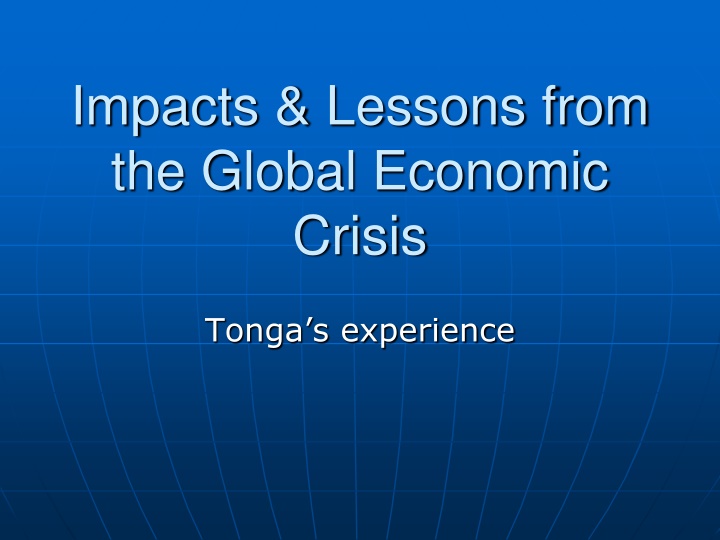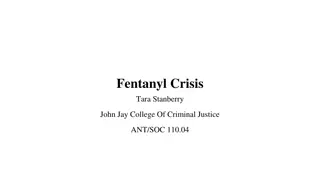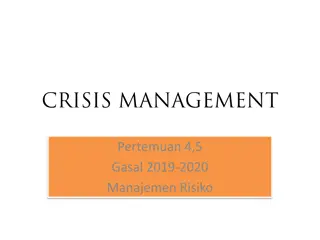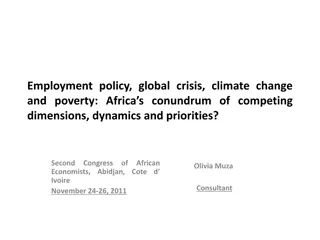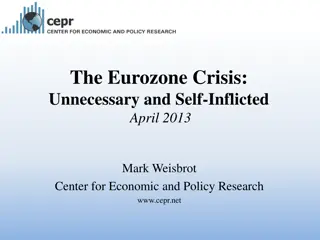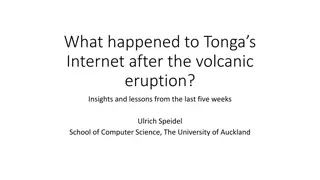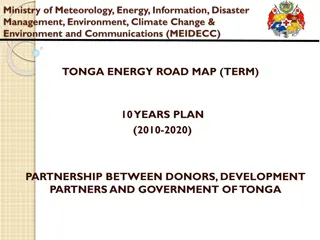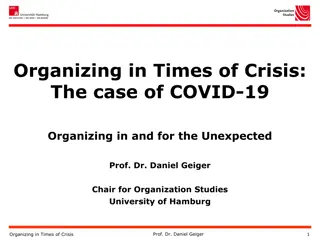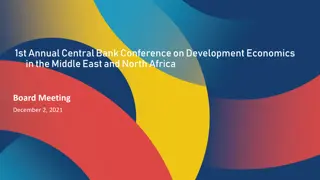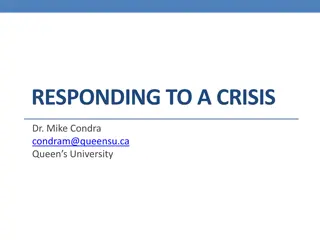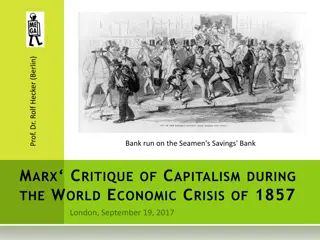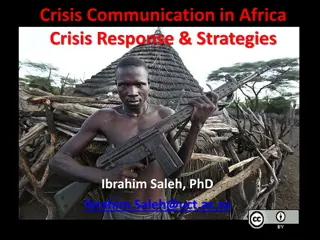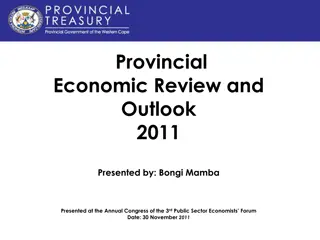Impacts & Lessons from the Global Economic Crisis: Tonga's Experience
Tonga, an archipelago of 172 islands in the South Pacific, faced economic impacts from the global crisis, leading to reduced remittances, imports, and revenue. The human costs included lower household income and decreased employment opportunities, highlighting the need for sound economic policies. Learn about Tonga's economy, trade channels, and policy lessons for global crises.
Download Presentation

Please find below an Image/Link to download the presentation.
The content on the website is provided AS IS for your information and personal use only. It may not be sold, licensed, or shared on other websites without obtaining consent from the author.If you encounter any issues during the download, it is possible that the publisher has removed the file from their server.
You are allowed to download the files provided on this website for personal or commercial use, subject to the condition that they are used lawfully. All files are the property of their respective owners.
The content on the website is provided AS IS for your information and personal use only. It may not be sold, licensed, or shared on other websites without obtaining consent from the author.
E N D
Presentation Transcript
Impacts & Lessons from the Global Economic Crisis Tonga s experience
Tonga an overview An archipelago of 172 islands in the South Pacific Population of 100,000 (in Tonga) Medium level of development (on UN HDI)
Tongas economy GDP of $USD 324m GDP per capita of USD$3,182
Tonga economic overview Main export = agricultural exports Economy main income sources as a % of GDP 31% Remittances 1.3% Aid Less than 5% from exports
Impacts of the GEC Remittances down by 13.6% as at end of June 09 Imports down by 32.4% from 07/08 to 08/09 Revised Revenue to T$142m down from $182m (.i.e.23% revision) or 6% of GDP GDP forecast down from 1.7% to 0.4%
Channels of economic impact from GEC Trade through Low exports and decline in imports resulting in a fall in trade taxes revenue Drop in Remittances due to increase in unemployment in source countries Fall in tourism receipts Adverse impact on contraction of domestic aggregate demand contributed by low business confidence and decline in credit for business investment
Impacts of the GEC-Human Cost In addition to the overall economic impacts of the GEC, the human costs implication includes: Reduction in household disposable income Decline in aggregate level of domestic economic activity causing reduction in employment creation opportunities Resort to social safety net and increase reliance on subsistence activities Adjustment to ways of meeting social obligations to save cost
Policy Lessons Learnt Globalisation and integration of global economic activity spares no one from global financial crisis and resulting economic downturn Important to develop accurate and robust information system for monitoring of movements in global and domestic economic activities for appropriate and timely decision making Maintain a sound financial system at all time with appropriate regulatory framework Vital to maintain a stable economic condition with adequate level of foreign reserves, low inflation, sufficient liquidity in the banking system and in public finance to enhance resilience and ability of economy to weather serious financial and economic storms 1. 2. 3. 4.
Cont; Policy Lessons from the GEC 5. Pursue sustainable development policy through encouraging innovation and new initiatives such as investment in renewable energy measures to mitigate external shocks; 6. Prudent macroeconomic and fiscal management to facilitate corrective actions due to external shocks 7. Synchronization and coordination of monetary and fiscal policy responses to stabilize the economy and restore the patch to economic growth . E.g. relaxing of monetary policy through reduction in SDR from 10% to 5%, market operation and moral suasion to reduce interest rates for lending 8. Continuing the economic and public sector reform and investment in necessary economic infrastructure for attaining long term sustainable growth and development 9. Specific and target measures to mitigate impact on vulnerable groups 10. Development of National Strategic Plan Framework to guide and coordinate the strategies to address the short and long challenges for achieving the overarching economic and social goals and prioritization of allocation of government and donors resources 11. Important to develop a medium term budgetary framework with a responsive development programs with donors, both bilateral and multilateral, to respond quickly when circumstances warrant. E.g. front loading of ADB grant program for budgetary support, IMF special SDR allocation to prop foreign reserves, and World Bank, Australia and New Zealand programs releasing resources for economic infrastructure investment creating jobs and foundation for future growth 12. Important to establish a sufficient Emergency fund and insurance measures for natural disasters
Cont; Lessons from the GFC 13. Secure fiscal resources to protect core public services including maintaining sufficient allocation for education and health services 14. Important for coordinating the action of Ministry of Finance and other government ministries in managing the budget in current economic climate to ensure maintaining essential public services in an efficient and effective manner to control potential fiscal deficit
Immediate Challenges from the GEC include Stabilization of the economy through implementing an appropriate mix of monetary and fiscal policy to sustain aggregate demand and avoid any further contraction Maintain a sound fiscal policy and increase aggregate demand through increasing expenditure for investment in economic infrastructure with financial assistance from donors Implement Fiscal stimulus through concessionary loans and aid financial assistance and ensuring value for money from fiscal stimulus package Assistance for vulnerable group Preserve resources for social services such as education and health Promote and encourage private sector investment through relaxing monetary policy and regulatory reform to enhance ease and cost of doing business Maintain an adequate level foreign reserves that support further private sector economic activities and movement in balance of payment
Useful International Policy Measures Providing and mobilizing quick financial resources to mitigate the impact of the economic downturn ( e.g. ADB, World Bank, IMF, AusAid and NZAid) to assist stabilizing the economy Improve local capacity for speed implementation of programs and projects to provide employment Ease conditions for providing financial aid assistance to provide quick direct budgetary support as well as balance of payment support Providing employment scheme ( e.g. Australia and NZ facilitating labor mobility) Further development of trade facilitation to increase trade exports with financial and TA assistance to improve exports infrastructure (e.g. heat plant)
Commonwealth role in sustained economic growth Australia and NZ continue to be the main bilateral donors COM SEC to continue to provide needed technical assistance to help capacity building in areas of its comparative advantage To increase provision of training for both public and private sector to accelerate economic growth Providing financial and technical assistance to support continuing efforts for achieving the MDG targets 1. 2. 3. 4.
Commonwealth role in sustained economic growth 5. Conducting country specific research into opportunities and challenges for economic growth
